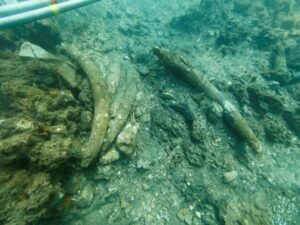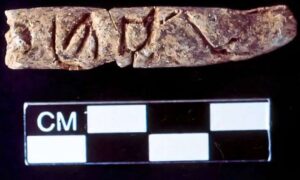Seventy-three intact burials, some adorned with intricately carved masks, have been unearthed at the historic Pachacámac archaeological site in Peru.
Krzysztof Makowski and his team led the discovery and documented the research on an archaeology blog run by the University of Warsaw.
These ancient mummies offer a new glimpse into the region’s cultural evolution and challenge previous assumptions.
The burial bundles, known as “fardos,” date back to the expansion of the Wari Empire from 800 to 1100 AD. Thanks to their excellent condition, the bundles provide additional insight about the social practices of the time.

Three of the burial bundles. Photo PUCP Archaeology Program
The masks, also called “false heads,” prove that families considered it a duty to “ensure the continuity of life after life,” Makowski said.
“After all, it is the dead who return each year to the land and look after the harvest,” he said. “On them also depends the abundance of water which flows down from the mountains to the deser, filling the irrigation channels.”

Krzysztof Makowski (second from right) and his team, including Cynthia Vargas, Domenico Villavicencio, Ana Fernandez and Christopher Beltran, during the documentation of one of the mummies. Photo M.Giersz
Mummies escaped vandalism
The research targeted an area where a collapsed wall from the Inca and colonial periods likely deterred grave robbers. This led to the discovery of the well-preserved burials.
Among the most notable findings are burials containing both men and women wearing the wooden and ceramic masks, or “false heads.”
The Pachacámac site, renowned for its Incan-period temple and oracle dedicated to the deity Pacha Kamaq, has long been a subject of archaeological interest. Previously, historians believed that it served as a sacred city until the Spanish conquest. But this new research tells a different story.

Another find: Two staves carved in wood with depictions of two dignitaries of the Wari Empire . Photo M. Giersz
During the Wari Empire period, Pachacámac appears to have functioned primarily as a settlement with a ceremonial platform.
Changes in burial practices and the iconography of a prominent idol, possibly the main object of worship in Pachacámac during the Wari period, indicate strong influences from the northern coast beliefs. Researchers also found two wooden staffs, adorned with images of dignitaries wearing Tiwanaku-type headgear.
Taken together, the find fuels the idea that the Wari period featured frequent cultural exchanges throughout the region.






